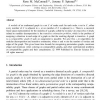Free Online Productivity Tools
i2Speak
i2Symbol
i2OCR
iTex2Img
iWeb2Print
iWeb2Shot
i2Type
iPdf2Split
iPdf2Merge
i2Bopomofo
i2Arabic
i2Style
i2Image
i2PDF
iLatex2Rtf
Sci2ools
DM
1999
1999
Modular decomposition and transitive orientation
A module of an undirected graph is a set X of nodes such for each node x not in X , either every member of X is adjacent to x, or no member of X is adjacent to x. There is a canonical linear-space representation for the modules of a graph, called the modular decomposition. Closely related to modular decomposition is the transitive orientation problem, which is the problem of assigning a direction to each edge of a graph so that the resulting digraph is transitive. A graph is a comparability graph if such an assignment is possible. We give O(n + m) algorithms for modular decomposition and transitive orientation, where n and m are the number of vertices and edges of the graph. This gives linear time bounds for recognizing permutation graphs, maximum clique and minimum vertex coloring on comparability graphs, and other combinatorial problems on comparability graphs and their complements. c 1999 Published by Elsevier Science B.V. All rights reserved
| Added | 22 Dec 2010 |
| Updated | 22 Dec 2010 |
| Type | Journal |
| Year | 1999 |
| Where | DM |
| Authors | Ross M. McConnell, Jeremy Spinrad |
Comments (0)

